BREED OF CATTLE AND BUFFALO
In this blog we have summarized the breed of cattle and buffalo with their important and unique characteristics. Indigenous Dairy Breed of cattle along with some important exotic breeds is also listed.
Indigenous Dairy Breed of cattle
Gir
- This breed is also known as Bhadawari, Desan, Gujarati, Kathiawari, Sorthi, and Surati.
- Origin place is Gir forest of South Kathiawar in Gujarat, but also found in Maharashtra and adjacent Rajasthan.
- Skin colours of this breed are white with dark red or chocolate-brown patches or sometimes black or purely red.
- Horns are peculiarly curved, giving a ‘half-moon’ appearance.
- Milk yield: 1200-1800 kgs per lactation.
- This bread is known for its hardiness and disease resistance
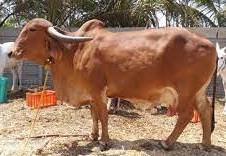
Red Sindhi
- Also known as Red Karachi, Sindhi and Mahi.
- Originated in Karachi and Hyderabad (Pakistan) regions of undivided India.
- Colour is red with shades varying from dark red to light, strips of white.
- Milk yield ranges from 1250 to 1800 kgs per lactation.
Sahiwal
- Best indigenous dairy breed.
- Others name- Lola (loose skin), Lambi Bar, Montgomery, Multani, Teli.
- Origin place- Montgomery region of undivided India.
- Reddish dun or pale red in colour, sometimes flashed with white patches.
- Heavy breed with symmetrical body with loose skin.
- The average milk yield of this breed ranges between 1400-2500 kgs per lactation.
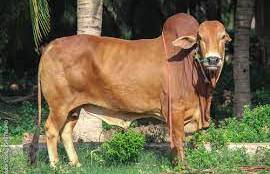
Draught purpose (Indigenous)
Hallikar
- Origin place- Vijayanagarm (old province), now part of Karnataka.
- The colour is grey or dark grey.
- Compact, muscular and medium size animal with prominent forehead, long horns and strong legs.
- The breed is best known for its draught capacity and especially for its trotting
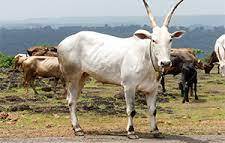
Amritmahal
- Originated in Hassan, Chikmagalur and Chitradurga district of Karnataka.
- Colours are grey cattle but their shade varies from almost white to near black.
- The muzzle, feat and tail are usually black.
- Horns are long and end in sharp black points.
Khillari
- Origin place is Sholapur and Sitapur districts of Maharashtra.
- Closely resembles Hallikar breed.
- Colour is Grey-white.
- Long horns turn forwards in a peculiar fashion. The horns are generally black, sometimes pinkish.
- Bullocks are fast and powerful.
Kangayam
- Other names are kongu and konganad.
- Originated in Kangayam, Dharapuram, Perundurai, Erode, Bhavani Coimbatore district.
- Cows are grey or white whereas, Bulls are grey with dark colour in hump, fore and hind quarters.
- The horns are spread apart, nearly straight with a slight curve backwards.
- The eyes are dark and prominent with black rings around them.
- Moderate size with compact bodies.
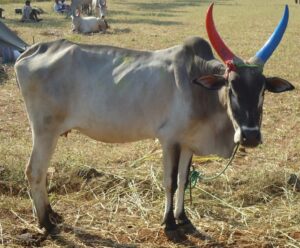
Bargur
- Originated in Bargur hills of Bhavani taluk of Erode district in Tamilnadu.
- Generally brown colour with white markings.
- Developed for work in uneven hilly terrains.
- Well-built animal, compact and medium in size.
- Known for their speed and endurance in trotting.
- Cautious in behaviour and tends to remain away from strangers.
Umblachery
- It is otherwise called as Jathi madu, Mottai madu, Molai madu, Therkathi madu.
- Origin- Thanjavur, Thiruvarur and Nagappattinam districts of Tamil Nadu.
- The breed is known for their strength and sturdiness, Suitable for wet ploughing.
- The practice of dehorning of bullocks is peculiar in Umblachery cattle.
Pulikulam
- Also known as Jallikattu madu, kidai madu, sentharai and mainly used for penning in the field.
- This breed is commonly seen in cumbum valley of Madurai district in Tamil Nadu.
- Small in size, usually grey or dark grey in colour.
- Well- developed hump.
- Useful for ploughing.
- Presence of reddish or brownish spots in muzzle, eyes, switch and back is the characteristic feature of this breed.
- Typical backward curving horns as Mysore type cattle.
- Breeds are active, useful draught animals but not fast trotter.
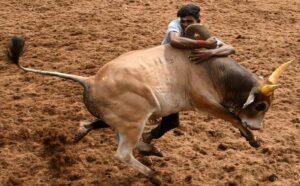
Alambadi
- Originated from Alambadi of Dharmapuri district in Tamilnadu. Breed is also called Betas.
- Grey or dark grey in colour.
- White markings will be seen in forehead, limb and tail.
- Horns are backward curving like Mysore cattle.
- Resembles Hallikar.
- Useful in ploughing.
Dual purpose (Indigenous breed)
Tharparkar
- Originated in Tharparkar district (Pakistan), also found in Rajasthan.
- Other names are White Sindhi, Gray Sindhi and Thari.
- Medium sized, compact and have lyre-shaped horn.
- Body colour is white or light grey.
- Bullocks are quite suitable for ploughing and casting.
- Yield- 1800 to 2600 kgs/lactation.
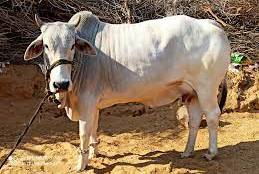
Hariana
- The breed is originated from Rohtak, Hisar, Jind and Gurgaon districts of Haryana and also popular in Punjab, UP and parts of MP.
- Horns are small.
- The bullocks are powerful work animals whereas, cows yields 600 to 800 kg of milk per lactation.
Kankrej
- It is otherwise called as Wadad or Waged, Wadhiar.
- Origin- Southeast Rann of Kutch district of Gujarat and adjoining Rajasthan.
- The horns are lyre-shaped.
- Colour varies from silver-grey to iron-grey or steel black.
- Manner of walking is peculiar called as sawai chal (1 ¼ paces).
- Fast, powerful, draught cattle, useful in ploughing and carting.
- The cows are good milkers, yields about 1400 kgs/lactation.
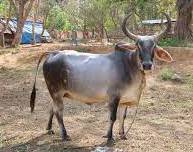
Ongole
- Also called as Nellore.
- Origin- Guntur district of Andhra Pradesh.
- White or light grey in colour.
- Large muscular breed with a well-developed hump.
- Suitable for heavy draught work.
- Average milk yield is 1000 kgs/lactation.
Krishna Valley
- Originated in Karnataka and also found in border districts of Maharastra.
- Animals are large, having a massive frame with deep, loosely built short body.
- Tail almost reaches the ground.
- Generally grey white in colour with a darker shade on fore quarters and hind quarters in male. Adult females are more whitish in appearance.
- Bullocks are useful for slow ploughing, and valued for their good working qualities.
- Yield is about 900 kgs per lactation.
Deoni
- Other names are Dongerpati, Dongari, Wannera, Waghyd, Balankya, Shevera.
- Origin- Western Andra Pradesh and also found in Marathwada region of Maharashtra and adjoining part of Karnataka.
- Body colour is usually spotted black and white.
- Cows yields from 636 to 1230 kgs per lactation, whereas, bullocks are suitable for heavy cultivation.
Exotic Dairy breed of cattle
Jersey
- In India this breed has acclimatized well and is widely used in cross breeding with indigenous cows.
- Origin- Jersey Island, U.K.
- Smallest dairy cattle.
- The typical colour of Jersey cattle is reddish fawn.
- Dished forehead; compact and angular body.
- Average milk yield is 4500 kgs/lactation with 4.5% fat.
Holstein Friesian
- Best yielder, average milk production is 6000-7000 kgs/lactation.
- Originated from the northern parts of Netherlands, especially in the province of Friesland.
- Largest dairy breed and ruggedly built is shape and possess large udder.
- Breeds have typical marking of black and white that make them easily distinguishable.
Brown Swiss
- Place of origin- mountainous region of Switzerland.
- Average milk yield is 5000 kgs per lactation.
- Karan Swiss is crossbred cattle obtained by crossing this breed with Sahiwal cattle at NDRI, Karnal.
Red Dane
- Origin- Denmark.
- Body colour is red, reddish brown or even dark brown.
- Yield varies from 3000 to 4000 kgs/lactation.
Ayrshire
- Origin- Ayrshire (Scotland).
- Considered as most beautiful dairy breed.
- These are very active animals but hard to manage.
- The breed was also known as Dunlop cattle or Cunningham cattle.
Guernsey
- Originated from Small island of Guernsey in France.
- Cherry red to brown in colour.
- The milk has a golden colour due to an exceptionally high content of beta carotene.
- Average yield- 6000 kgs/lactation.
- High efficiency of milk production, low incidence of calving difficulty and longevity makes it notable breed for the dairy farmer over other breeds.
Buffalo Breeds
Murrah
- Most important breed of buffaloes, also known as Delhi, Kundi and Kali.
- Home tract is Rohtak, Hisar and Sind of Haryana, Nabha and Patiala districts of Punjab and southern parts of Delhi state.
- The colour is usually jet black with white markings on tail and face.
- Tightly curved horn is an important character of this breed.
- Most efficient milk (1500 to 2500 kgs/lactation) and butter fat (7.83 %.) producers in India.
- Also used for the grading up of inferior local buffaloes.
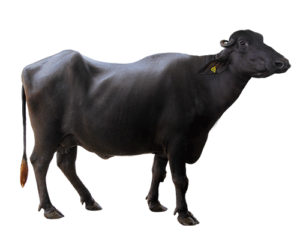
Surti
- Other names are Deccani, Gujarati, Talabda, Charator and Nadiadi.
- Breeding tract- Kaira and Baroda district of Gujarat.
- Coat colour varies from rusty brown to silver-grey.
- The horns are sickle shaped, moderately long and flat.
- The peculiarity of the breed is two white collars, one round the jaw and the other at the brisket region.
- The milk yield ranges from 1000 to 1300 kgs per lactation with very high fat percentage in milk (8-12per cent).
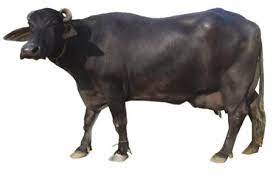
Jaffrabadi
- This is the heaviest Indian breed of buffalo.
- Origin- Gir forests, Kutch and Jamnagar districts of Gujarat.
- The horns are heavy, inclined to droop at each side of the neck and then turning up at point (drooping horns).
- The udder is well developed with funnel shaped teats.
- The average milk yield is 1000-1200 kgs/lactation.
- The bullocks are heavy and used for ploughing and carting.
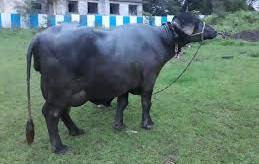
Bhadawari
- This breed is known for its high butter fat content varies from 6-12.5%.
- Home tract of this breed is Agra and Etawah district of Uttar Pradesh and Gwalior district of Madhya Pradesh.
- Medium sized buffalo, body is usually light or copper coloured. Eye lids are generally copper or light brown colour.
- Two white lines ‘Chevron’ are present at the lower side of the neck similar to that of Surti buffaloes.
- The average milk yield is 800 to 1000 kgs per lactation.
- The bullocks are good draught animal with high heat tolerance.
Nili Ravi
- Originated around the river Ravi.
- The peculiarity of the breed is the wall eyes.
- Horns are very small and tightly coiled.
- Bullocks are good for heavy trotting work.
- The milk yield is 1500-1850 kgs/lactation.
Mehsana
- Found in Mehsana, Sabarkanta and Banaskanta districts of Gujarat and adjoining Maharashtra state.
- The breed is cross bred of Surti and the Murrah.
- The milk yield is 1200-1500 kgs per lactation.
Nagpuri
- Also called as Elitchpuri or Barari.
- Breeding tract- Nagpur, Akola and Amrawati districts of Maharashtra.
- Black coloured animal, Sword shaped horns.
- The bullocks can be used for heavy work.
- Yield- 700-1200 kgs/lactation.
Toda
- This buffalo is named after an ancient tribe, Toda of Nilgiris Hills of south India and it is a semi-wild breed.
- Thick hair coat is found all over the body.
- They are gregarious in nature.
- The horns are set wide apart curving inward, outward and forward forming a characteristic crescent shape.
- The average milk yield is 500 kgs per lactation with high fat content of 8%.
Read also…
SYSTEMS OF BREEDING- DIFFERENT METHODS
ANIMAL BREEDING- BREEDING AND VARIATION
ANIMAL HUSBANDRY MCQ PART 1